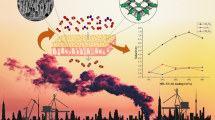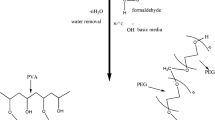Abstract
Polyacrylamide (PAAm)-silica organic-inorganic hybrid membranes for carbon dioxide (CO2) separation were prepared via in-situ polymerization. Formation of silica and PAAm via sol-gel method and in-situ polymerization was confirmed by IR spectroscopy. Single gas permeances through the membranes were measured at 298, 373 and 423 K using CO2, He and N2. The ideal separation factor (the ratio of the permeances) of CO2/N2 through the AAm10 membrane (starting solution composition; tetraethoxysilane: methyltriethoxysilane: distilled water: hydrochloric acid: ethanol: acrylamide: dimethyl 2,2′-azobis(isobutyrate) = 0.4: 0.6: 2: 0.01: 20: 1.0: 0.1 in molar ratio) was 25.4 at 298 K. This value was thirty times higher than the theoretical Knudsen value (CO2/N2 = 0.8). Binary gas permeation at 298 K was also investigated using a gas mixture of 50%CO2–50%N2. The ideal separation factor (the ratio of the permeances) of CO2/N2 through the membrane was 24.9. This value was the same as the ideal separation factor of CO2/N2 calculated from the single gas measurement. Such a high CO2 selectivity in 50%CO2-50%N2 feed gas was also found even at high temperature for this membrane.

Graphical abstract
Highlights
-
Polyacrylamide-silica organic-inorganic hybrid membranes for carbon dioxide (CO2) separation were prepared via in-situ polymerization.
-
The effects of acrylamide (AAm) content on the gas permeances of CO2, He, N2 through the membranes were investigated.
-
AAm10 membrane (starting solution composition; tetraethoxysilane: methyltriethoxysilane: distilled water: hydrochloric acid: ethanol: acrylamide: dimethyl 2,2′-azobis(isobutyrate) = 0.4:0.6:2:0.01:20:1.0:0.1 in molar ratio) exhibits the highest CO2 selectivity, the ideal separation factor (the ratio of the permeances) of CO2/N2 was 25.4 at 298 K.
-
AAm10 membrane exhibited high CO2 selectivity at 298 K for 50%CO2-50%N2 feed gas mixture, where the ideal separation factor (the ratio of the permeances) of CO2/N2 was 24.9.





Similar content being viewed by others
References
Masson- Delmotte V, Zhai P, Pirani A, Connors SL, Péan C, Berger S, Caud N, Chen Y, Goldfarb L, Gomis MI, Huang M, Leitzell K, Lonnoy E, Matthews JBR, Maycock TK, Waterfield T, Yelekçi O, Yu R, Zhou B (in Press) IPCC, 2021: Summary for Policymakers. In: Climate Change 2021: The Physical Science Basis. Contribution of Working Group I to the Sixth Assessment Report of the Intergovernmental Panel on Climate Change.
Ahmed R, Liu G, Yousaf B, Abbas Q, Ullah H, Ali MU (2020) Recent advances in carbon-based renewable adsorbent for selective carbon dioxide capture and separation-A review. J Clean Prod 242:118409. https://doi.org/10.1016/j.jclepro.2019.118409
Míguez JL, Porteiro J, Pérez-Orozco R, Gómez MÁ (2018) Technology Evolution in Membrane-Based CCS. Energies 11 (11). https://doi.org/10.3390/en11113153
Baena-Moreno FM, le Saché E, Pastor-Pérez L, Reina TR (2020) Membrane-based technologies for biogas upgrading: a review. Environ Chem Lett 18(5):1649–1658. https://doi.org/10.1007/s10311-020-01036-3
Gouveia ASL, Ventaja L, Tomé LC, Marrucho IM (2018) Towards Biohydrogen Separation Using Poly(Ionic Liquid)/Ionic Liquid Composite Membranes. Membranes 8 (4). https://doi.org/10.3390/membranes8040124
Scholes CA, Stevens GW, Kentish SE (2012) Membrane gas separation applications in natural gas processing. Fuel 96:15–28. https://doi.org/10.1016/j.fuel.2011.12.074
Hazazi K, Ma X, Wang Y, Ogieglo W, Alhazmi A, Han Y, Pinnau I (2019) Ultra-selective carbon molecular sieve membranes for natural gas separations based on a carbon-rich intrinsically microporous polyimide precursor. J Membr Sci 585:1–9. https://doi.org/10.1016/j.memsci.2019.05.020
Wong KK, Jawad ZA (2019) A review and future prospect of polymer blend mixed matrix membrane for CO2 separation. J Polym Res 26(12):289. https://doi.org/10.1007/s10965-019-1978-z
Ahmad NNR, Leo CP, Mohammad AW, Shaari N, Ang WL (2021) Recent progress in the development of ionic liquid-based mixed matrix membrane for CO2 separation: A review. Int J Energy Res 45(7):9800–9830. https://doi.org/10.1002/er.6518
Venna SR, Carreon MA (2015) Metal organic framework membranes for carbon dioxide separation. Chem Eng Sci 124:3–19. https://doi.org/10.1016/j.ces.2014.10.007
Kumar R, Zhang C, Itta AK, Koros WJ (2019) Highly permeable carbon molecular sieve membranes for efficient CO2/N2 separation at ambient and subambient temperatures. J Membr Sci 583:9–15. https://doi.org/10.1016/j.memsci.2019.04.033
Lei L, Lindbråthen A, Zhang X, Favvas EP, Sandru M, Hillestad M, He X (2020) Preparation of carbon molecular sieve membranes with remarkable CO2/CH4 selectivity for high-pressure natural gas sweetening. J Membr Sci 614:118529. https://doi.org/10.1016/j.memsci.2020.118529
Tomita T, Nakayama K, Sakai H (2004) Gas separation characteristics of DDR type zeolite membrane. Microporous Mesoporous Mater 68(1):71–75. https://doi.org/10.1016/j.micromeso.2003.11.016
Hasegawa Y, Abe C, Natsui M, Ikeda A (2021) Gas permeation properties of high-silica CHA-type zeolite membrane. Membranes 11 (4). https://doi.org/10.3390/membranes11040249
Cao Z, Anjikar ND, Yang S (2022) Small-pore zeolite membranes: a review of gas separation applications and membrane preparation. Separations 9 (2). https://doi.org/10.3390/separations9020047
Kuraoka K, Tanaka H, Yazawa T (1996) Highly selective separation of CO2 and He by xerogel coated porous glass membrane. J Mater Sci Lett 15(1):1–3. https://doi.org/10.1007/BF01855593
Pera-Titus M (2014) Porous inorganic membranes for CO2 capture: present and prospects. Chem Rev 114(2):1413–1492. https://doi.org/10.1021/cr400237k
Sridhar S, Smitha B, Aminabhavi TM (2007) Separation of carbon dioxide from natural gas mixtures through polymeric membranes—a review. Sep Purif Rev 36(2):113–174. https://doi.org/10.1080/15422110601165967
Russo F, Galiano F, Iulianelli A, Basile A, Figoli A (2021) Biopolymers for sustainable membranes in CO2 separation: a review. Fuel Process Technol 213:106643. https://doi.org/10.1016/j.fuproc.2020.106643
Kim H, Lim C, Hong S-I (2005) Gas permeation properties of organic-inorganic hybrid membranes prepared from hydroxyl-terminated polyether and 3-isocyanatopropyltriethoxysilane. J Sol-Gel Sci Technol 36(2):213–221. https://doi.org/10.1007/s10971-005-3782-y
Kanezashi M, Yada K, Yoshioka T, Tsuru T (2010) Organic–inorganic hybrid silica membranes with controlled silica network size: Preparation and gas permeation characteristics. J Membr Sci 348(1):310–318. https://doi.org/10.1016/j.memsci.2009.11.014
Chua ML, Shao L, Low BT, Xiao Y, Chung T-S (2011) Polyetheramine–polyhedral oligomeric silsesquioxane organic–inorganic hybrid membranes for CO2/H2 and CO2/N2 separation. J Membr Sci 385-386:40–48. https://doi.org/10.1016/j.memsci.2011.09.008
Minhas FT, Farrukh S, Hussain A, Mujahid M (2015) Comparison of silica and novel functionalized silica-based cellulose acetate hybrid membranes in gas permeation study. J Polym Res 22(4):63. https://doi.org/10.1007/s10965-015-0701-y
Kubo M, Kojima M, Mano R, Daiko Y, Honda S, Iwamoto Y (2020) A hydrostable mesoporous γ-Al2O3 membrane modified with Si–C–H organic-inorganic hybrid derived from polycarbosilane. J Membr Sci 598:117799. https://doi.org/10.1016/j.memsci.2019.117799
Zhao Y, Zhou C, Kong C, Chen L (2021) Ultrathin reduced graphene oxide/organosilica hybrid membrane for gas separation. JACS Au 1(3):328–335. https://doi.org/10.1021/jacsau.0c00073
Ramadan H, Coradin T, Masse S, El-Rassy H (2011) Synthesis and characterization of mesoporous hybrid silica-polyacrylamide aerogels and xerogels. Silicon 3(2):63–75. https://doi.org/10.1007/s12633-010-9064-5
Illescas J, Sanna R, Alzari V, Nuvoli D, Casu M, Sanna R, Rivera E, Mariani A (2013) Organic–inorganic interpenetrating polymer networks and hybrid polymer materials prepared by frontal polymerization. J Polym Sci A: Polym Chem 51(21):4618–4625. https://doi.org/10.1002/pola.26882
El-Mahdy GA, Atta AM, Al-Lohedan HA, Tawfik AM, Abdel-Khalek AA (2015) Application of Silica/polyacrylamide nanocomposite as Anticorrosive layer for Steel. Int J Electrochem Sci 10(1):151–161
Mirbagheri M, Hill RJ (2017) Sorption and diffusion of moisture in silica-polyacrylamide nanocomposite films. Polymer 122:359–371. https://doi.org/10.1016/j.polymer.2017.04.071
Ghasemi S, Karim S (2018) Organic/inorganic hybrid composed of modified polyacrylamide grafted silica supported Pd nanoparticles using RAFT polymerization process: Controlled synthesis, characterization and catalytic activity. Mater Chem Phys 205:347–358. https://doi.org/10.1016/j.matchemphys.2017.11.041
Slisenko O, Mamunya Y (2019) Novel highly hydrophilic organic/inorganic composites based on polyacrylamide and silica: synthesis strategy, structure and swelling behaviour. J Polym Res 26(7):164. https://doi.org/10.1007/s10965-019-1823-4
Tong Z, Ho WSW (2017) Facilitated transport membranes for CO2 separation and capture. Sep Sci Technol 52(2):156–167. https://doi.org/10.1080/01496395.2016.1217885
Kuraoka K, Kubo N, Yazawa T (2000) Microporous silica xerogel membrane with high selectivity and high permeance for carbon dioxide separation. J Sol-Gel Sci Technol 19(1):515–518. https://doi.org/10.1023/A:1008728320293
Kuraoka K, Chujo Y, Yazawa T (2001) Hydrocarbon separation via porous glass membranes surface-modified using organosilane compounds. J Membr Sci 182(1):139–149. https://doi.org/10.1016/S0376-7388(00)00559-7
Zhuang G-L, Wu C-F, Wey M-Y, Tseng H-H (2021) Impacts of green synthesis process on asymmetric hybrid PDMS membrane for efficient CO2/N2 Separation. Membranes 11 (1). https://doi.org/10.3390/membranes11010059
Orme CJ, Harrup MK, Luther TA, Lash RP, Houston KS, Weinkauf DH, Stewart FF (2001) Characterization of gas transport in selected rubbery amorphous polyphosphazene membranes. J Membr Sci 186(2):249–256. https://doi.org/10.1016/S0376-7388(00)00690-6
Robeson LM (2008) The upper bound revisited. J Membr Sci 320(1):390–400. https://doi.org/10.1016/j.memsci.2008.04.030
Kazama S, Teramoto T, Haraya K (2002) Carbon dioxide and nitrogen transport properties of bis(phenyl)fluorene-based cardo polymer membranes. J Membr Sci 207(1):91–104. https://doi.org/10.1016/S0376-7388(02)00112-6
Innocenzi P, Abdirashid MO, Guglielmi M (1994) Structure and properties of sol-gel coatings from methyltriethoxysilane and tetraethoxysilane. J Sol-Gel Sci Technol 3(1):47–55. https://doi.org/10.1007/BF00490148
Gaabour LH (2017) Spectroscopic and thermal analysis of polyacrylamide/chitosan (PAM/CS) blend loaded by gold nanoparticles. Results Phys 7:2153–2158. https://doi.org/10.1016/j.rinp.2017.06.027
Jang J, Park H (2002) Formation and structure of polyacrylamide–silica nanocomposites by sol–gel process. J Appl Polym Sci 83(8):1817–1823. https://doi.org/10.1002/app.10116
Jonathan N (1961) The infrared and Raman spectra and structure of acrylamide. J Mol Spectrosc 6:205–214. https://doi.org/10.1016/0022-2852(61)90243-0
Pandey P, Chauhan RS (2001) Membranes for gas separation. Prog Polym Sci 26(6):853–893. https://doi.org/10.1016/S0079-6700(01)00009-0
Rafiq S, Deng L, Hägg M-B (2016) Role of facilitated transport membranes and composite membranes for efficient CO2 Capture – A Review. ChemBioEng Rev 3(2):68–85. https://doi.org/10.1002/cben.201500013
Bos A, Pünt IGM, Wessling M, Strathmann H (1999) CO2-induced plasticization phenomena in glassy polymers. J Membr Sci 155(1):67–78. https://doi.org/10.1016/S0376-7388(98)00299-3
Funding
This work was supported by JSPS KAKENHI Grant Number JP19K12397.
Author information
Authors and Affiliations
Contributions
All authors contributed to the study conception and design. Material preparation, data collection and analysis were performed by KK and RY. The first draft of the manuscript was written by KK and all authors commented on previous versions of the manuscript. All authors read and approved the final manuscript.
Corresponding author
Ethics declarations
Conflict of interest
The authors declare no competing interests.
Additional information
Publisher’s note Springer Nature remains neutral with regard to jurisdictional claims in published maps and institutional affiliations.
Rights and permissions
About this article
Cite this article
Kuraoka, K., Yamamoto, R. Preparation of polyacrylamide-silica organic-inorganic hybrid membranes for carbon dioxide separation via in-situ polymerization. J Sol-Gel Sci Technol 104, 470–477 (2022). https://doi.org/10.1007/s10971-022-05890-1
Received:
Accepted:
Published:
Issue Date:
DOI: https://doi.org/10.1007/s10971-022-05890-1




